Social Stratification: Conflict, Functionalist, and Feminist Views
VerifiedAdded on 2019/09/26
|10
|1906
|320
Essay
AI Summary
This essay provides a comprehensive overview of social stratification, a system that categorizes individuals and groups in a hierarchical order, leading to social inequality. It explores the principles of social stratification, highlighting its persistence across generations and its universality. The essay delves into various sociological perspectives, including the conflict perspective (Marx), symbolic interactionist perspective, functionalist perspective, and feminist perspective. Each perspective is examined in detail, providing examples and explanations of their core concepts and how they view society. The essay concludes by emphasizing the importance of understanding equality and the potential for reducing the negative effects of social stratification, advocating for equal opportunities and respect for all to build a better society. The essay uses multiple references to support the claims and theories that are discussed throughout the essay.
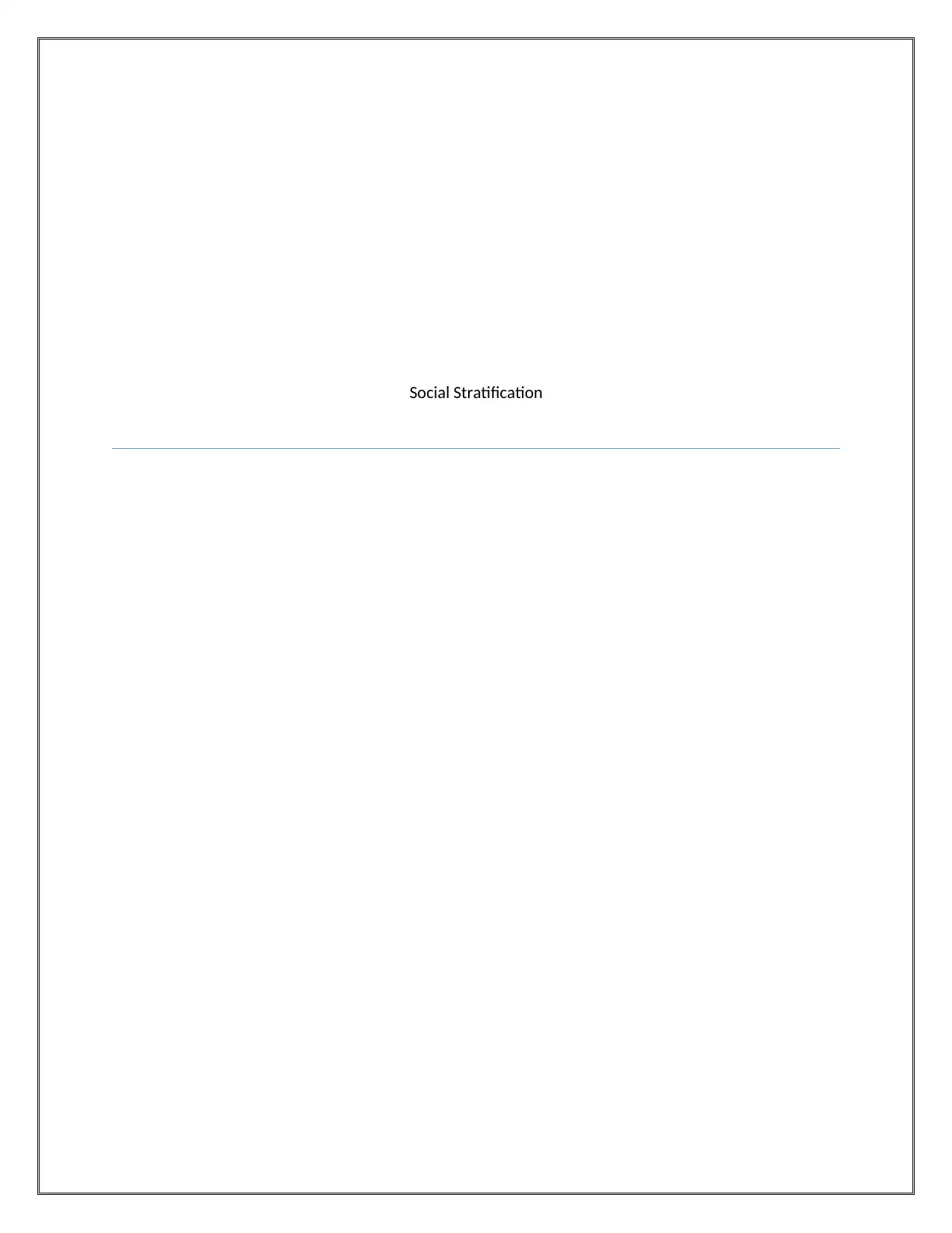
Social Stratification
Paraphrase This Document
Need a fresh take? Get an instant paraphrase of this document with our AI Paraphraser
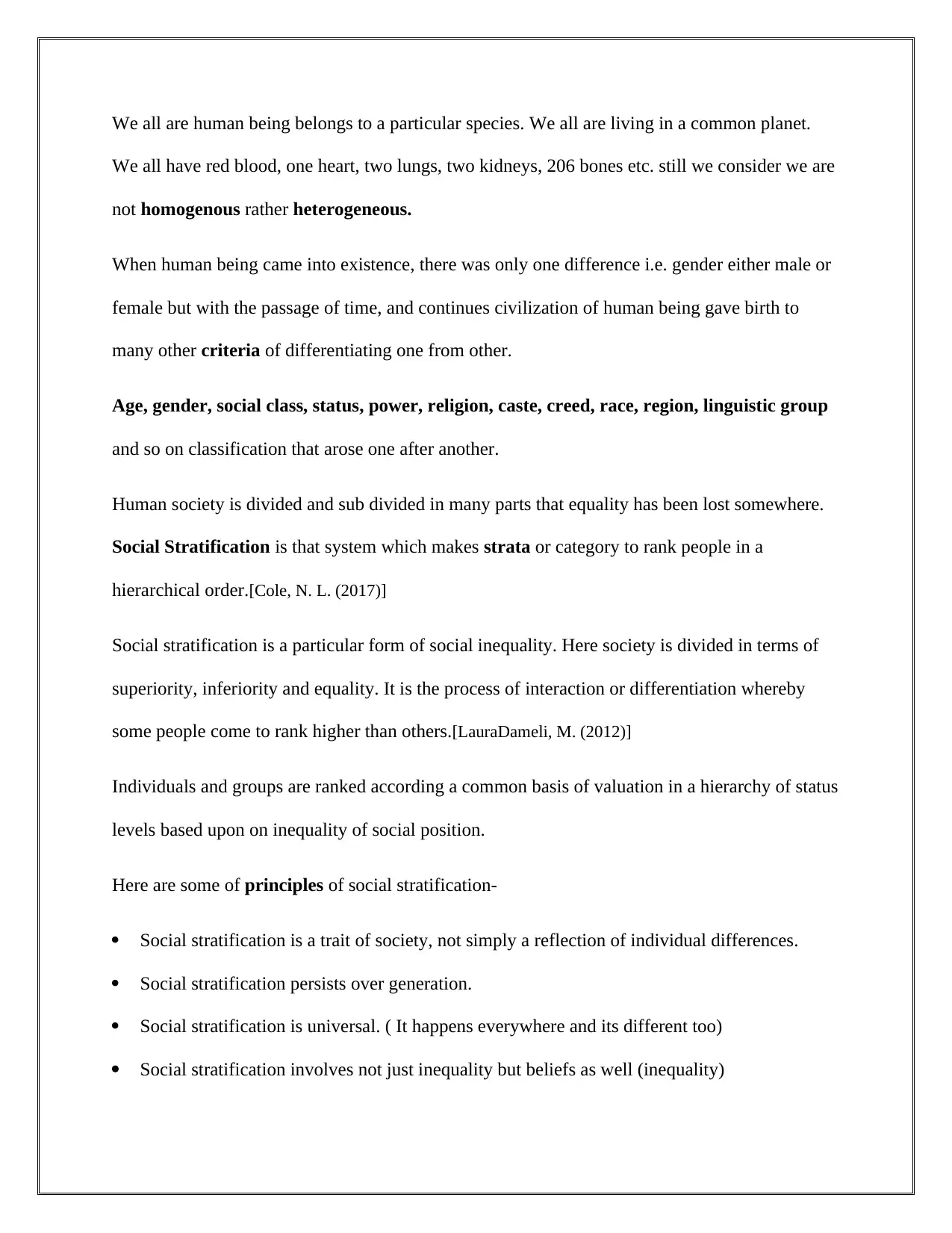
We all are human being belongs to a particular species. We all are living in a common planet.
We all have red blood, one heart, two lungs, two kidneys, 206 bones etc. still we consider we are
not homogenous rather heterogeneous.
When human being came into existence, there was only one difference i.e. gender either male or
female but with the passage of time, and continues civilization of human being gave birth to
many other criteria of differentiating one from other.
Age, gender, social class, status, power, religion, caste, creed, race, region, linguistic group
and so on classification that arose one after another.
Human society is divided and sub divided in many parts that equality has been lost somewhere.
Social Stratification is that system which makes strata or category to rank people in a
hierarchical order.[Cole, N. L. (2017)]
Social stratification is a particular form of social inequality. Here society is divided in terms of
superiority, inferiority and equality. It is the process of interaction or differentiation whereby
some people come to rank higher than others.[LauraDameli, M. (2012)]
Individuals and groups are ranked according a common basis of valuation in a hierarchy of status
levels based upon on inequality of social position.
Here are some of principles of social stratification-
Social stratification is a trait of society, not simply a reflection of individual differences.
Social stratification persists over generation.
Social stratification is universal. ( It happens everywhere and its different too)
Social stratification involves not just inequality but beliefs as well (inequality)
We all have red blood, one heart, two lungs, two kidneys, 206 bones etc. still we consider we are
not homogenous rather heterogeneous.
When human being came into existence, there was only one difference i.e. gender either male or
female but with the passage of time, and continues civilization of human being gave birth to
many other criteria of differentiating one from other.
Age, gender, social class, status, power, religion, caste, creed, race, region, linguistic group
and so on classification that arose one after another.
Human society is divided and sub divided in many parts that equality has been lost somewhere.
Social Stratification is that system which makes strata or category to rank people in a
hierarchical order.[Cole, N. L. (2017)]
Social stratification is a particular form of social inequality. Here society is divided in terms of
superiority, inferiority and equality. It is the process of interaction or differentiation whereby
some people come to rank higher than others.[LauraDameli, M. (2012)]
Individuals and groups are ranked according a common basis of valuation in a hierarchy of status
levels based upon on inequality of social position.
Here are some of principles of social stratification-
Social stratification is a trait of society, not simply a reflection of individual differences.
Social stratification persists over generation.
Social stratification is universal. ( It happens everywhere and its different too)
Social stratification involves not just inequality but beliefs as well (inequality)
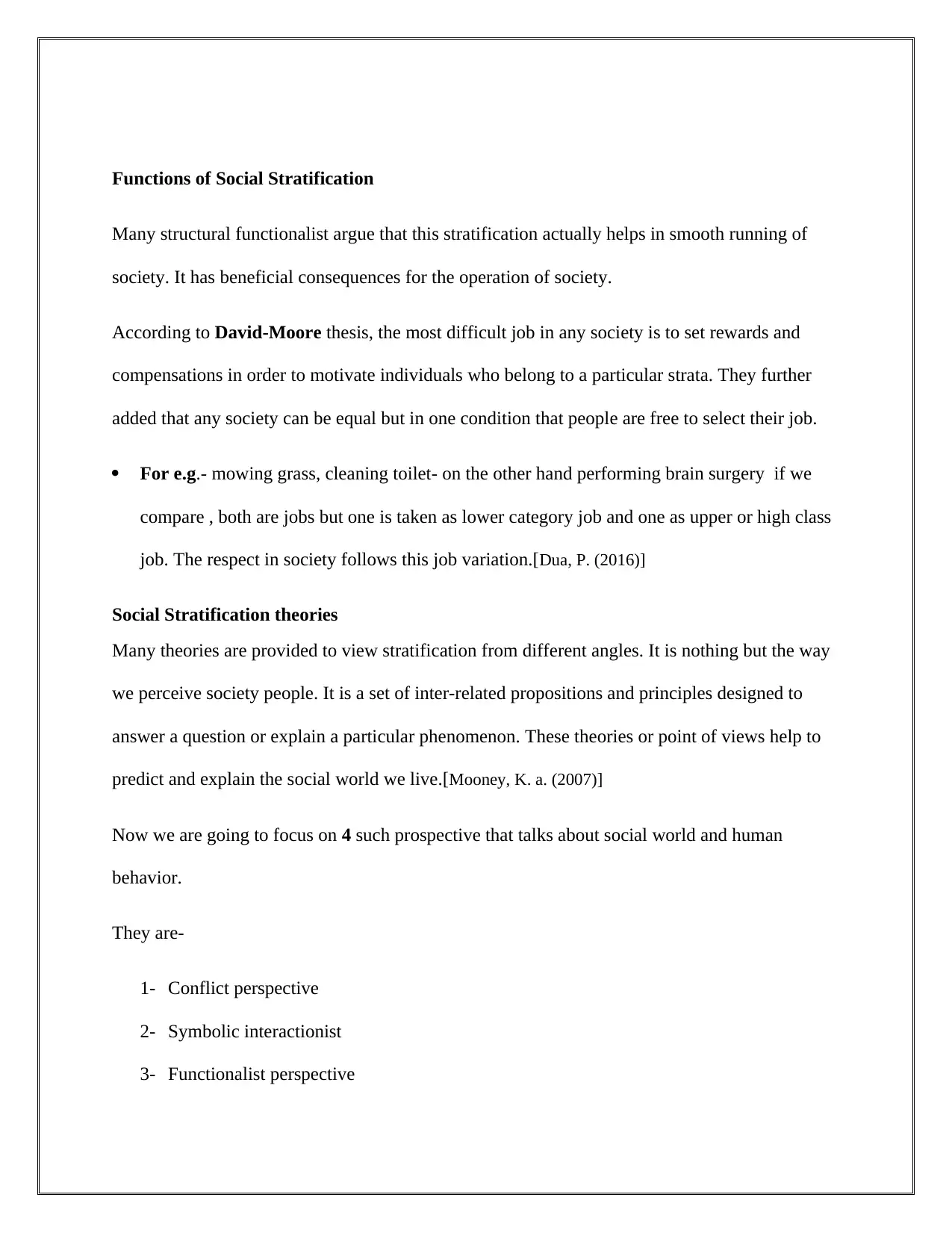
Functions of Social Stratification
Many structural functionalist argue that this stratification actually helps in smooth running of
society. It has beneficial consequences for the operation of society.
According to David-Moore thesis, the most difficult job in any society is to set rewards and
compensations in order to motivate individuals who belong to a particular strata. They further
added that any society can be equal but in one condition that people are free to select their job.
For e.g.- mowing grass, cleaning toilet- on the other hand performing brain surgery if we
compare , both are jobs but one is taken as lower category job and one as upper or high class
job. The respect in society follows this job variation.[Dua, P. (2016)]
Social Stratification theories
Many theories are provided to view stratification from different angles. It is nothing but the way
we perceive society people. It is a set of inter-related propositions and principles designed to
answer a question or explain a particular phenomenon. These theories or point of views help to
predict and explain the social world we live.[Mooney, K. a. (2007)]
Now we are going to focus on 4 such prospective that talks about social world and human
behavior.
They are-
1- Conflict perspective
2- Symbolic interactionist
3- Functionalist perspective
Many structural functionalist argue that this stratification actually helps in smooth running of
society. It has beneficial consequences for the operation of society.
According to David-Moore thesis, the most difficult job in any society is to set rewards and
compensations in order to motivate individuals who belong to a particular strata. They further
added that any society can be equal but in one condition that people are free to select their job.
For e.g.- mowing grass, cleaning toilet- on the other hand performing brain surgery if we
compare , both are jobs but one is taken as lower category job and one as upper or high class
job. The respect in society follows this job variation.[Dua, P. (2016)]
Social Stratification theories
Many theories are provided to view stratification from different angles. It is nothing but the way
we perceive society people. It is a set of inter-related propositions and principles designed to
answer a question or explain a particular phenomenon. These theories or point of views help to
predict and explain the social world we live.[Mooney, K. a. (2007)]
Now we are going to focus on 4 such prospective that talks about social world and human
behavior.
They are-
1- Conflict perspective
2- Symbolic interactionist
3- Functionalist perspective
⊘ This is a preview!⊘
Do you want full access?
Subscribe today to unlock all pages.

Trusted by 1+ million students worldwide
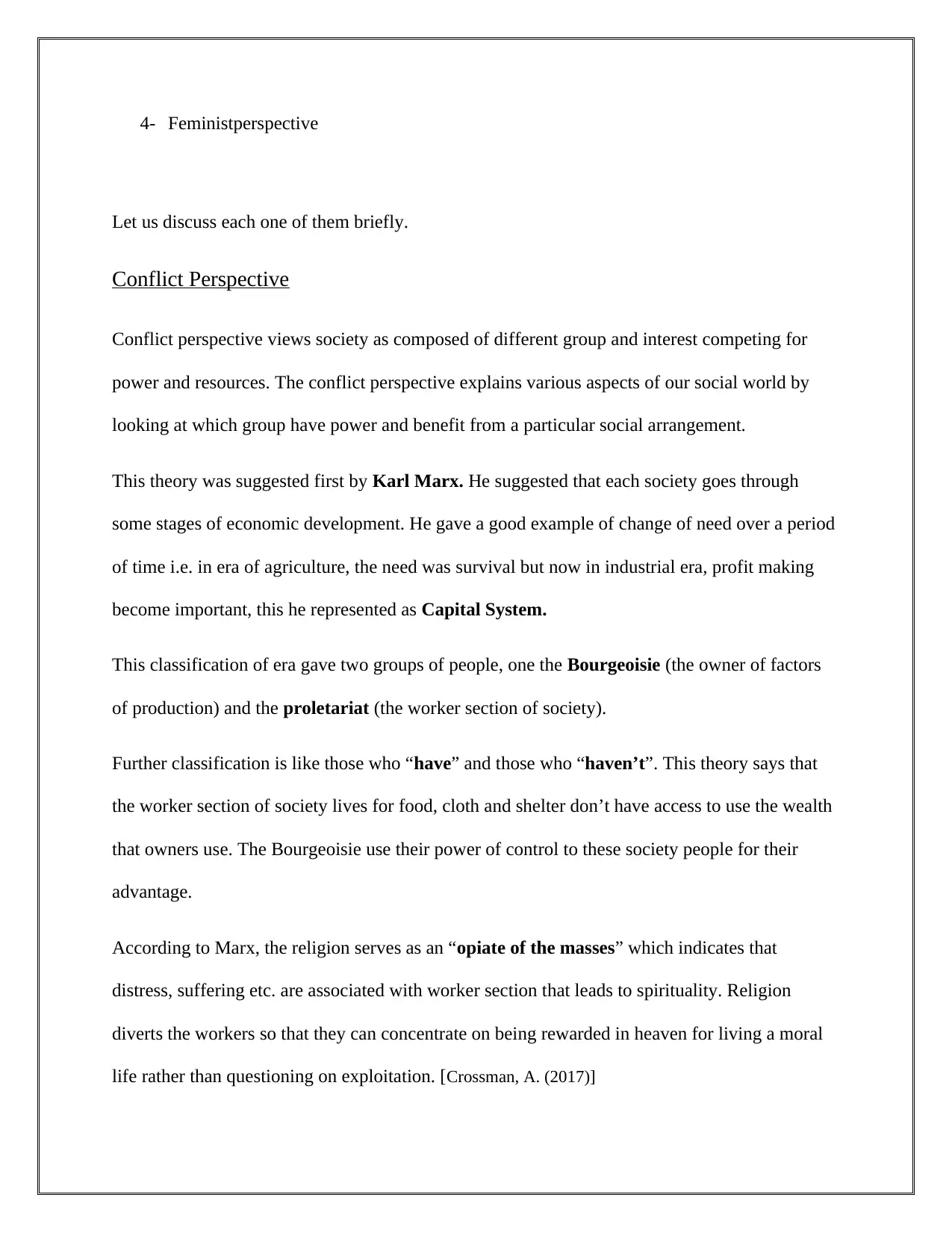
4- Feministperspective
Let us discuss each one of them briefly.
Conflict Perspective
Conflict perspective views society as composed of different group and interest competing for
power and resources. The conflict perspective explains various aspects of our social world by
looking at which group have power and benefit from a particular social arrangement.
This theory was suggested first by Karl Marx. He suggested that each society goes through
some stages of economic development. He gave a good example of change of need over a period
of time i.e. in era of agriculture, the need was survival but now in industrial era, profit making
become important, this he represented as Capital System.
This classification of era gave two groups of people, one the Bourgeoisie (the owner of factors
of production) and the proletariat (the worker section of society).
Further classification is like those who “have” and those who “haven’t”. This theory says that
the worker section of society lives for food, cloth and shelter don’t have access to use the wealth
that owners use. The Bourgeoisie use their power of control to these society people for their
advantage.
According to Marx, the religion serves as an “opiate of the masses” which indicates that
distress, suffering etc. are associated with worker section that leads to spirituality. Religion
diverts the workers so that they can concentrate on being rewarded in heaven for living a moral
life rather than questioning on exploitation. [Crossman, A. (2017)]
Let us discuss each one of them briefly.
Conflict Perspective
Conflict perspective views society as composed of different group and interest competing for
power and resources. The conflict perspective explains various aspects of our social world by
looking at which group have power and benefit from a particular social arrangement.
This theory was suggested first by Karl Marx. He suggested that each society goes through
some stages of economic development. He gave a good example of change of need over a period
of time i.e. in era of agriculture, the need was survival but now in industrial era, profit making
become important, this he represented as Capital System.
This classification of era gave two groups of people, one the Bourgeoisie (the owner of factors
of production) and the proletariat (the worker section of society).
Further classification is like those who “have” and those who “haven’t”. This theory says that
the worker section of society lives for food, cloth and shelter don’t have access to use the wealth
that owners use. The Bourgeoisie use their power of control to these society people for their
advantage.
According to Marx, the religion serves as an “opiate of the masses” which indicates that
distress, suffering etc. are associated with worker section that leads to spirituality. Religion
diverts the workers so that they can concentrate on being rewarded in heaven for living a moral
life rather than questioning on exploitation. [Crossman, A. (2017)]
Paraphrase This Document
Need a fresh take? Get an instant paraphrase of this document with our AI Paraphraser
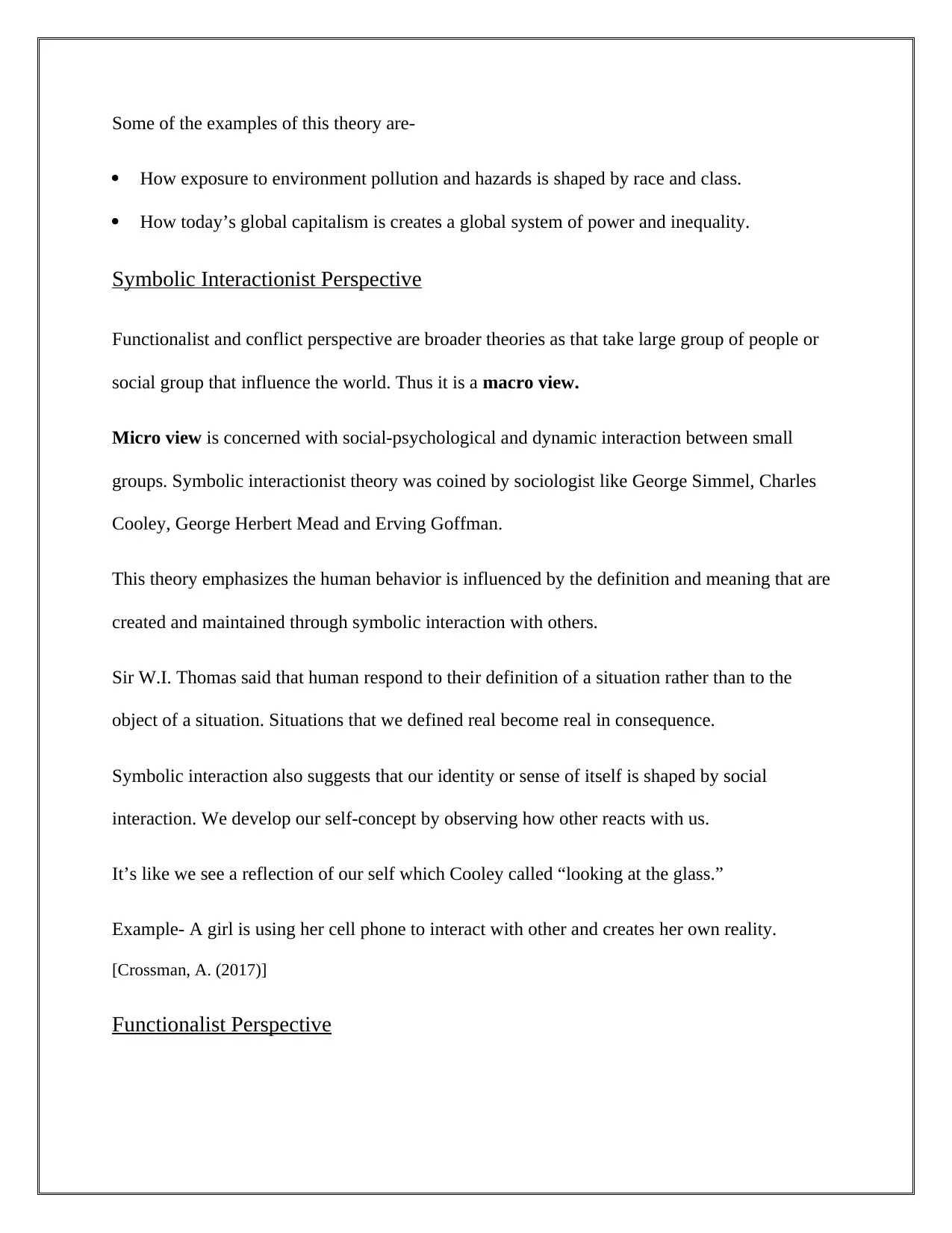
Some of the examples of this theory are-
How exposure to environment pollution and hazards is shaped by race and class.
How today’s global capitalism is creates a global system of power and inequality.
Symbolic Interactionist Perspective
Functionalist and conflict perspective are broader theories as that take large group of people or
social group that influence the world. Thus it is a macro view.
Micro view is concerned with social-psychological and dynamic interaction between small
groups. Symbolic interactionist theory was coined by sociologist like George Simmel, Charles
Cooley, George Herbert Mead and Erving Goffman.
This theory emphasizes the human behavior is influenced by the definition and meaning that are
created and maintained through symbolic interaction with others.
Sir W.I. Thomas said that human respond to their definition of a situation rather than to the
object of a situation. Situations that we defined real become real in consequence.
Symbolic interaction also suggests that our identity or sense of itself is shaped by social
interaction. We develop our self-concept by observing how other reacts with us.
It’s like we see a reflection of our self which Cooley called “looking at the glass.”
Example- A girl is using her cell phone to interact with other and creates her own reality.
[Crossman, A. (2017)]
Functionalist Perspective
How exposure to environment pollution and hazards is shaped by race and class.
How today’s global capitalism is creates a global system of power and inequality.
Symbolic Interactionist Perspective
Functionalist and conflict perspective are broader theories as that take large group of people or
social group that influence the world. Thus it is a macro view.
Micro view is concerned with social-psychological and dynamic interaction between small
groups. Symbolic interactionist theory was coined by sociologist like George Simmel, Charles
Cooley, George Herbert Mead and Erving Goffman.
This theory emphasizes the human behavior is influenced by the definition and meaning that are
created and maintained through symbolic interaction with others.
Sir W.I. Thomas said that human respond to their definition of a situation rather than to the
object of a situation. Situations that we defined real become real in consequence.
Symbolic interaction also suggests that our identity or sense of itself is shaped by social
interaction. We develop our self-concept by observing how other reacts with us.
It’s like we see a reflection of our self which Cooley called “looking at the glass.”
Example- A girl is using her cell phone to interact with other and creates her own reality.
[Crossman, A. (2017)]
Functionalist Perspective
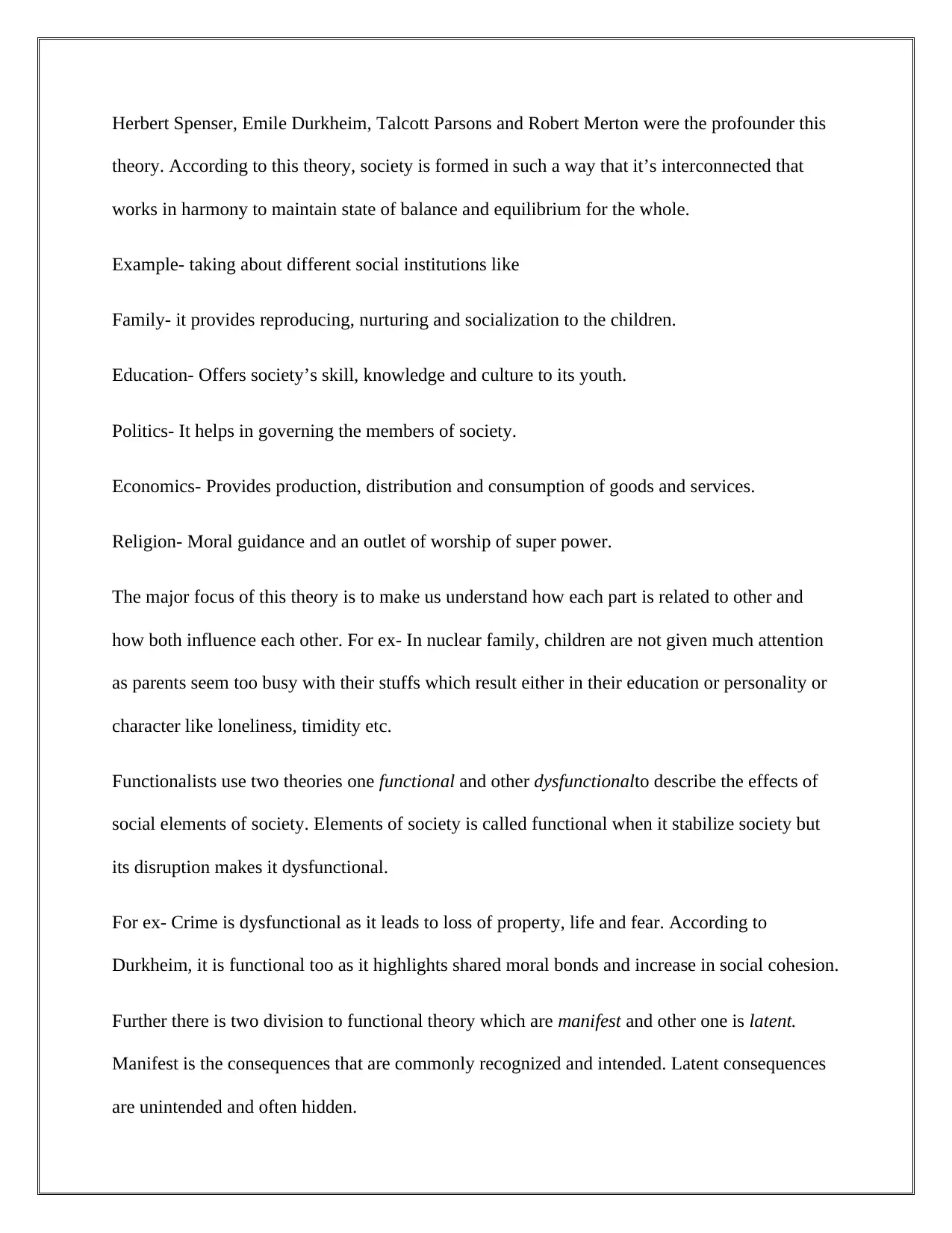
Herbert Spenser, Emile Durkheim, Talcott Parsons and Robert Merton were the profounder this
theory. According to this theory, society is formed in such a way that it’s interconnected that
works in harmony to maintain state of balance and equilibrium for the whole.
Example- taking about different social institutions like
Family- it provides reproducing, nurturing and socialization to the children.
Education- Offers society’s skill, knowledge and culture to its youth.
Politics- It helps in governing the members of society.
Economics- Provides production, distribution and consumption of goods and services.
Religion- Moral guidance and an outlet of worship of super power.
The major focus of this theory is to make us understand how each part is related to other and
how both influence each other. For ex- In nuclear family, children are not given much attention
as parents seem too busy with their stuffs which result either in their education or personality or
character like loneliness, timidity etc.
Functionalists use two theories one functional and other dysfunctionalto describe the effects of
social elements of society. Elements of society is called functional when it stabilize society but
its disruption makes it dysfunctional.
For ex- Crime is dysfunctional as it leads to loss of property, life and fear. According to
Durkheim, it is functional too as it highlights shared moral bonds and increase in social cohesion.
Further there is two division to functional theory which are manifest and other one is latent.
Manifest is the consequences that are commonly recognized and intended. Latent consequences
are unintended and often hidden.
theory. According to this theory, society is formed in such a way that it’s interconnected that
works in harmony to maintain state of balance and equilibrium for the whole.
Example- taking about different social institutions like
Family- it provides reproducing, nurturing and socialization to the children.
Education- Offers society’s skill, knowledge and culture to its youth.
Politics- It helps in governing the members of society.
Economics- Provides production, distribution and consumption of goods and services.
Religion- Moral guidance and an outlet of worship of super power.
The major focus of this theory is to make us understand how each part is related to other and
how both influence each other. For ex- In nuclear family, children are not given much attention
as parents seem too busy with their stuffs which result either in their education or personality or
character like loneliness, timidity etc.
Functionalists use two theories one functional and other dysfunctionalto describe the effects of
social elements of society. Elements of society is called functional when it stabilize society but
its disruption makes it dysfunctional.
For ex- Crime is dysfunctional as it leads to loss of property, life and fear. According to
Durkheim, it is functional too as it highlights shared moral bonds and increase in social cohesion.
Further there is two division to functional theory which are manifest and other one is latent.
Manifest is the consequences that are commonly recognized and intended. Latent consequences
are unintended and often hidden.
⊘ This is a preview!⊘
Do you want full access?
Subscribe today to unlock all pages.

Trusted by 1+ million students worldwide
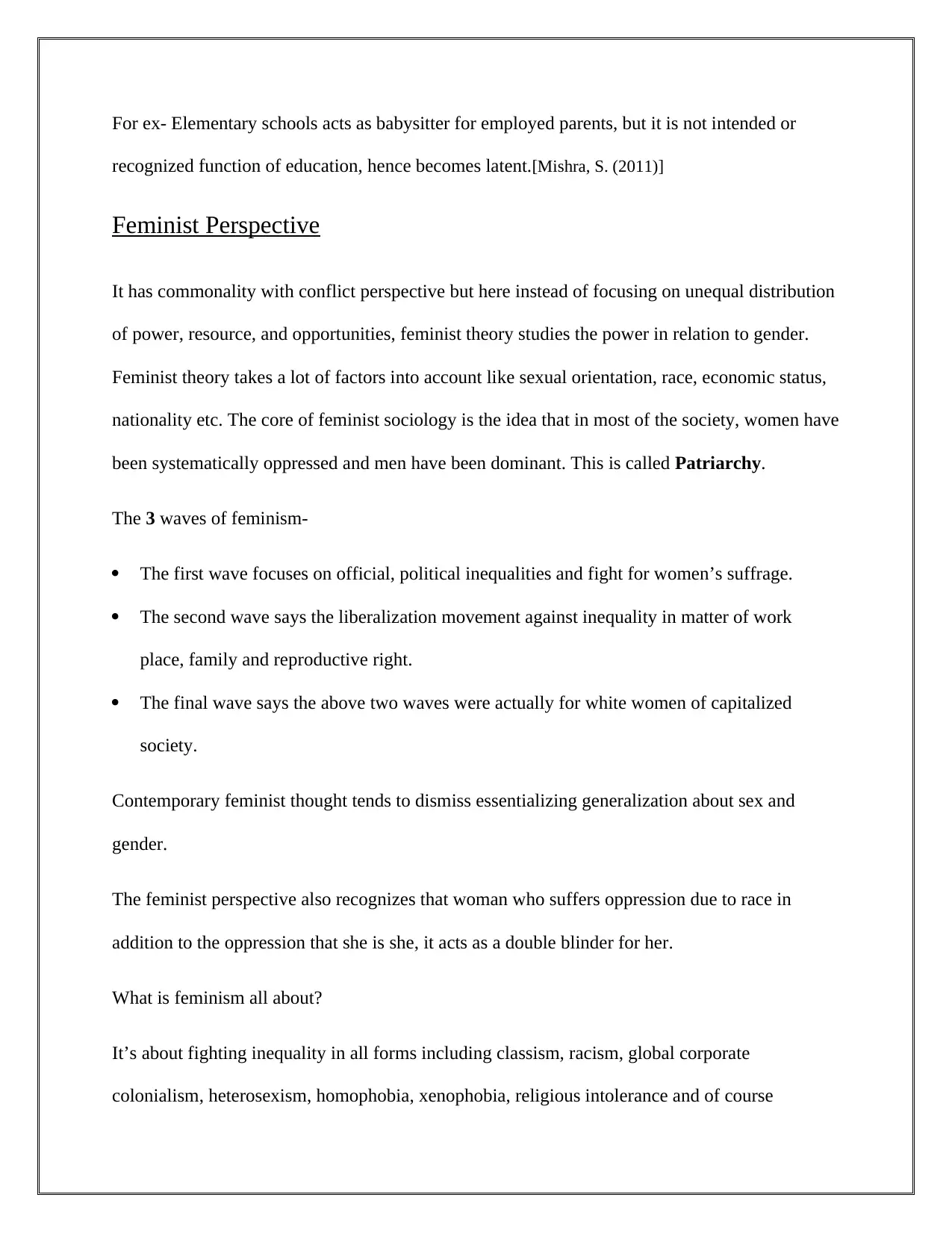
For ex- Elementary schools acts as babysitter for employed parents, but it is not intended or
recognized function of education, hence becomes latent.[Mishra, S. (2011)]
Feminist Perspective
It has commonality with conflict perspective but here instead of focusing on unequal distribution
of power, resource, and opportunities, feminist theory studies the power in relation to gender.
Feminist theory takes a lot of factors into account like sexual orientation, race, economic status,
nationality etc. The core of feminist sociology is the idea that in most of the society, women have
been systematically oppressed and men have been dominant. This is called Patriarchy.
The 3 waves of feminism-
The first wave focuses on official, political inequalities and fight for women’s suffrage.
The second wave says the liberalization movement against inequality in matter of work
place, family and reproductive right.
The final wave says the above two waves were actually for white women of capitalized
society.
Contemporary feminist thought tends to dismiss essentializing generalization about sex and
gender.
The feminist perspective also recognizes that woman who suffers oppression due to race in
addition to the oppression that she is she, it acts as a double blinder for her.
What is feminism all about?
It’s about fighting inequality in all forms including classism, racism, global corporate
colonialism, heterosexism, homophobia, xenophobia, religious intolerance and of course
recognized function of education, hence becomes latent.[Mishra, S. (2011)]
Feminist Perspective
It has commonality with conflict perspective but here instead of focusing on unequal distribution
of power, resource, and opportunities, feminist theory studies the power in relation to gender.
Feminist theory takes a lot of factors into account like sexual orientation, race, economic status,
nationality etc. The core of feminist sociology is the idea that in most of the society, women have
been systematically oppressed and men have been dominant. This is called Patriarchy.
The 3 waves of feminism-
The first wave focuses on official, political inequalities and fight for women’s suffrage.
The second wave says the liberalization movement against inequality in matter of work
place, family and reproductive right.
The final wave says the above two waves were actually for white women of capitalized
society.
Contemporary feminist thought tends to dismiss essentializing generalization about sex and
gender.
The feminist perspective also recognizes that woman who suffers oppression due to race in
addition to the oppression that she is she, it acts as a double blinder for her.
What is feminism all about?
It’s about fighting inequality in all forms including classism, racism, global corporate
colonialism, heterosexism, homophobia, xenophobia, religious intolerance and of course
Paraphrase This Document
Need a fresh take? Get an instant paraphrase of this document with our AI Paraphraser
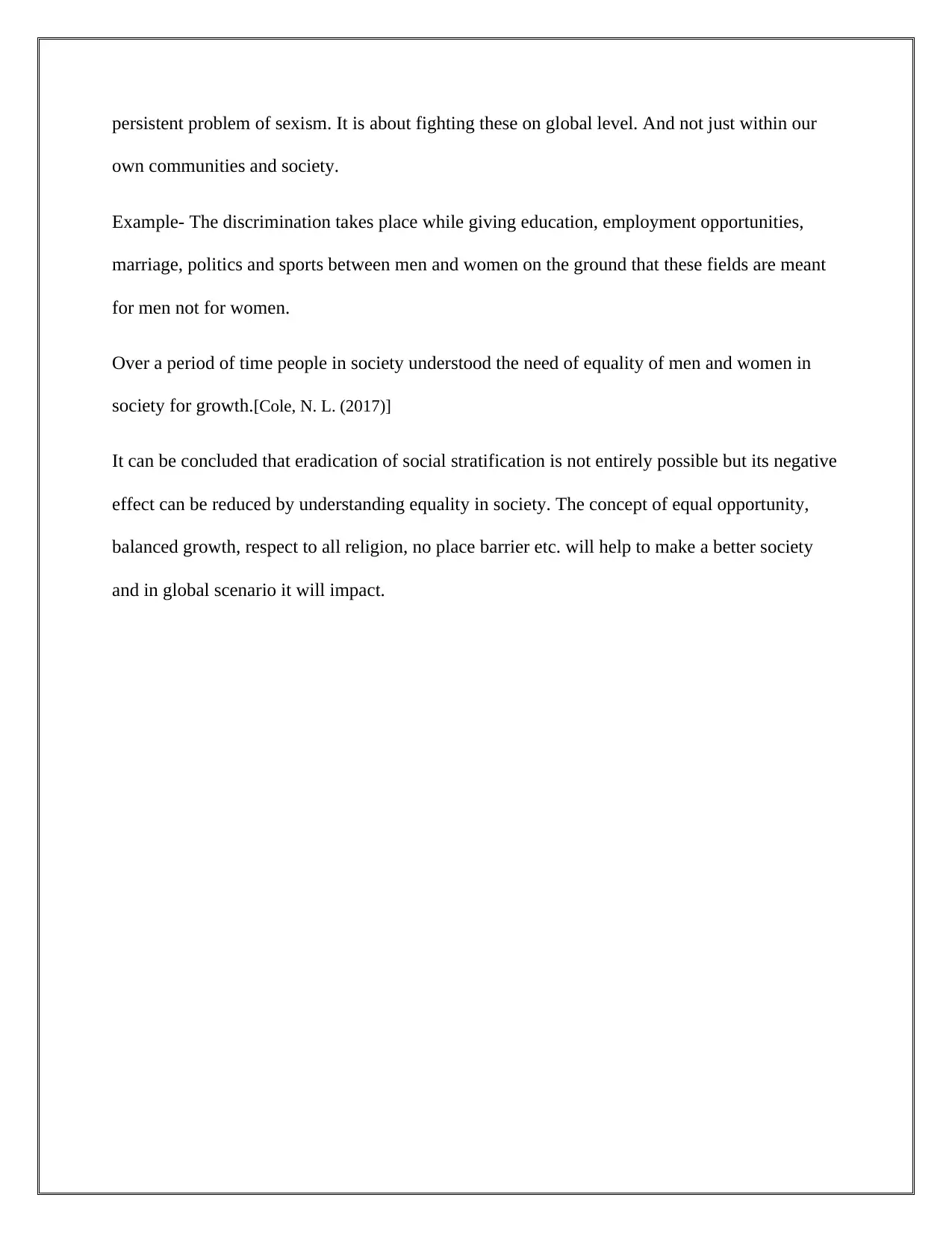
persistent problem of sexism. It is about fighting these on global level. And not just within our
own communities and society.
Example- The discrimination takes place while giving education, employment opportunities,
marriage, politics and sports between men and women on the ground that these fields are meant
for men not for women.
Over a period of time people in society understood the need of equality of men and women in
society for growth.[Cole, N. L. (2017)]
It can be concluded that eradication of social stratification is not entirely possible but its negative
effect can be reduced by understanding equality in society. The concept of equal opportunity,
balanced growth, respect to all religion, no place barrier etc. will help to make a better society
and in global scenario it will impact.
own communities and society.
Example- The discrimination takes place while giving education, employment opportunities,
marriage, politics and sports between men and women on the ground that these fields are meant
for men not for women.
Over a period of time people in society understood the need of equality of men and women in
society for growth.[Cole, N. L. (2017)]
It can be concluded that eradication of social stratification is not entirely possible but its negative
effect can be reduced by understanding equality in society. The concept of equal opportunity,
balanced growth, respect to all religion, no place barrier etc. will help to make a better society
and in global scenario it will impact.
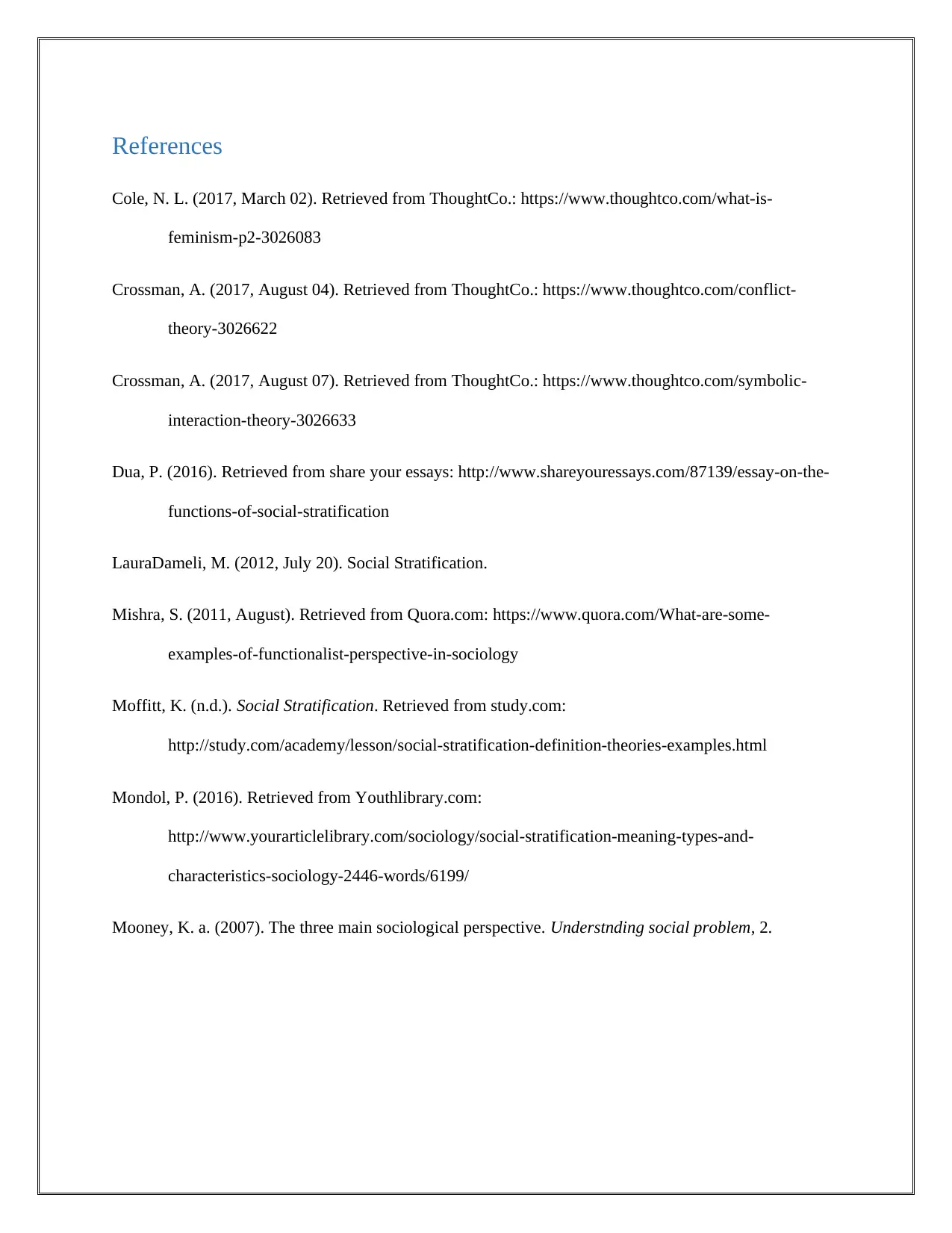
References
Cole, N. L. (2017, March 02). Retrieved from ThoughtCo.: https://www.thoughtco.com/what-is-
feminism-p2-3026083
Crossman, A. (2017, August 04). Retrieved from ThoughtCo.: https://www.thoughtco.com/conflict-
theory-3026622
Crossman, A. (2017, August 07). Retrieved from ThoughtCo.: https://www.thoughtco.com/symbolic-
interaction-theory-3026633
Dua, P. (2016). Retrieved from share your essays: http://www.shareyouressays.com/87139/essay-on-the-
functions-of-social-stratification
LauraDameli, M. (2012, July 20). Social Stratification.
Mishra, S. (2011, August). Retrieved from Quora.com: https://www.quora.com/What-are-some-
examples-of-functionalist-perspective-in-sociology
Moffitt, K. (n.d.). Social Stratification. Retrieved from study.com:
http://study.com/academy/lesson/social-stratification-definition-theories-examples.html
Mondol, P. (2016). Retrieved from Youthlibrary.com:
http://www.yourarticlelibrary.com/sociology/social-stratification-meaning-types-and-
characteristics-sociology-2446-words/6199/
Mooney, K. a. (2007). The three main sociological perspective. Understnding social problem, 2.
Cole, N. L. (2017, March 02). Retrieved from ThoughtCo.: https://www.thoughtco.com/what-is-
feminism-p2-3026083
Crossman, A. (2017, August 04). Retrieved from ThoughtCo.: https://www.thoughtco.com/conflict-
theory-3026622
Crossman, A. (2017, August 07). Retrieved from ThoughtCo.: https://www.thoughtco.com/symbolic-
interaction-theory-3026633
Dua, P. (2016). Retrieved from share your essays: http://www.shareyouressays.com/87139/essay-on-the-
functions-of-social-stratification
LauraDameli, M. (2012, July 20). Social Stratification.
Mishra, S. (2011, August). Retrieved from Quora.com: https://www.quora.com/What-are-some-
examples-of-functionalist-perspective-in-sociology
Moffitt, K. (n.d.). Social Stratification. Retrieved from study.com:
http://study.com/academy/lesson/social-stratification-definition-theories-examples.html
Mondol, P. (2016). Retrieved from Youthlibrary.com:
http://www.yourarticlelibrary.com/sociology/social-stratification-meaning-types-and-
characteristics-sociology-2446-words/6199/
Mooney, K. a. (2007). The three main sociological perspective. Understnding social problem, 2.
⊘ This is a preview!⊘
Do you want full access?
Subscribe today to unlock all pages.

Trusted by 1+ million students worldwide

1 out of 10
Related Documents
Your All-in-One AI-Powered Toolkit for Academic Success.
+13062052269
info@desklib.com
Available 24*7 on WhatsApp / Email
![[object Object]](/_next/static/media/star-bottom.7253800d.svg)
Unlock your academic potential
Copyright © 2020–2025 A2Z Services. All Rights Reserved. Developed and managed by ZUCOL.





